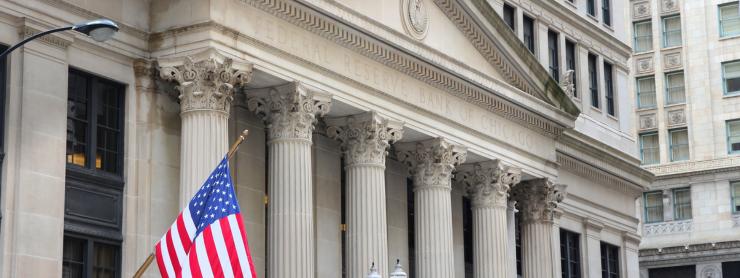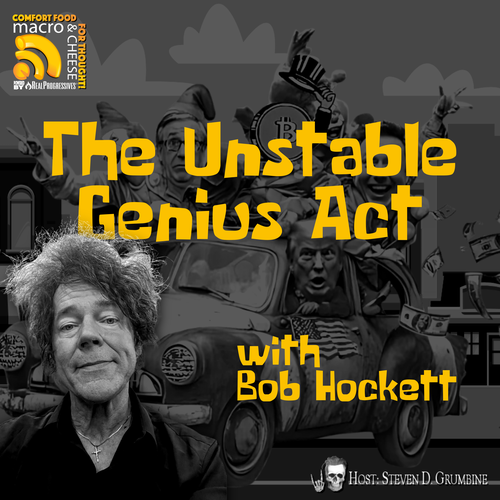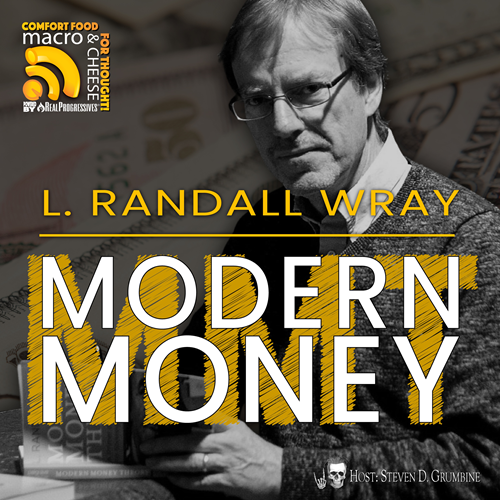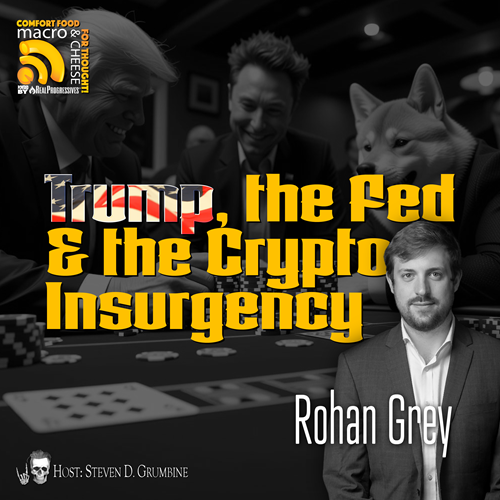Originally posted on January 10, 2014 at the New Economic Perspectives blog.
Last time we took a historical perspective on supposed Fed independence. In this blog we look at the myth of Fed independence from its creator, the Congress and from the Treasury.
Independent from Congress: Discretion in Selecting Tools
The strongest case for Fed independence would be in its discretion to choose the tools and targets to pursue Congressional mandates. Congress has shown little interest in interfering with the details of monetary policy implementation, preferring only to mandate the ultimate goals. The period from 1979 to the mid 1980s was an exception as Congress had become enamored with Milton Friedman’s monetarist focus on growth of the money supply. Even after the Fed had dropped money growth targets from serious consideration, Congress still wanted the Fed to provide them. However, for the most part, Congress leaves these details to the Fed.
If we recall the old textbooks, there was a distinction among tools, targets, and goals. Goals are usually defined in terms of unemployment, inflation, and growth; in the case of the US, there is the dual (or quadruple) mandate but it is itself vague. The Fed does not set specific goals (ie, specific inflation rates or unemployment rates), although a number of central banks have adopted narrow ranges for acceptable inflation rates. In that case there is a synthesis of target and goal—the central bank targets an inflation rate that serves as a measure of monetary policy success; employment and output growth are then expected by-products of hitting the inflation target. However, the Fed has not followed that practice, preferring greater discretionary leeway.
Since inflation, by itself, would not seem to be a sufficient goal of policy-making, either the inflation target could be changed if it were inconsistent with other goals, or the other goals would be moved to the sphere of fiscal policy. The less extreme policy (and the one adopted in the US) is to target “the” interest rate to hit the goals. In practice there are many interest rates, so central banks typically target the overnight interbank rate (fed funds rate in the US) with a view to affecting other market rates. However, as there is no close correspondence between “the” interest rate and the Congressionally-mandated goals (that are themselves vague), the Fed has a great deal of discretion over its setting of the interest rate target. In practice, almost any rate target could be justified as consistent with the goals.
The old monetarist preference was instead for a quantitative target (reserves) that would allow the central bank to control money growth. That was then supposed to allow the central bank to keep inflation low—although monetarists tended to argue against accelerating inflation rather than against inflation as the economic costs of a low-to-moderate but stable inflation rate were not believed to be high. In any case, except where legislative mandate sets an inflation target, central banks are typically left to choose their targets (except when it comes to war finance—as discussed below). Modern central banks have dropped monetary (quantitative) targets in favor of interest rate (price) targets—both because they are easier to hit and because current thinking is that they are more reliably linked to the goals.
That then leaves the policy tools available: open market operations and discount window lending rates. Again, these typically are seen to be within the discretion of the central bank. In the case of the US, the early Fed relied on the discount window until it “discovered” open market effects on bank reserves; there was a debate in the early postwar period about the relative advantages of each (with Hyman Minsky arguing forcefully for reliance on the discount window rather than open market operations—and monetarists taking the opposite position), largely decided in favor of open market operations.
The dominance of that “market” approach was all the more obvious in the GFC as the Fed created an alphabet soup of facilities to provide reserves “to the market” through auctions rather than lending them to banks at the discount window. The argument has long been that forcing banks to the discount window penalizes them through demonstration effects or “frown costs”. (Canada has for some time offered an alternative, in which the central bank pays interest on positive reserve balances and charges an overdraft fee for banks that are short; there are presumably no “frown costs”.) During the debate in the 1960s, monetarists preferred open market operations on the argument that this better protects market forces—to allocate reserves and also to determine interest rates. However, if the Fed sets the discount rate and announces a fed funds rate target, the market is not setting those rates. Still, the way the Fed auctioned reserves during the crisis would seem more consistent with the market-based approach.
In conclusion, “independence” could refer to choice of tools—discount window versus open market purchases to supply reserves, discount window or overnight markets to determine interest rates, and required reserve ratios to determine deposit multipliers.
Independence from Treasury: Fiscal and Monetary Policy Operations
The US got its central bank only in 1913, although it had brief experiments with the First and Second Banks of the United States and as well with special rights granted to national banks. With those exceptions, the Treasury, itself, provided most of the central banking functions until the FRA of 1913 created the Fed. MacLaury summarizes the evolution of Fed and Treasury sharing of responsibilities as follows:
The central bank is in constant contact with the Treasury Department which, among other things, is responsible for the management of the public debt and its various cash accounts. Prior to the existence of the Federal Reserve System, the Treasury actually carried out many monetary functions. And even since, the Treasury has often been deeply involved in monetary functions, especially during the earlier years. At the beginning of World War II, it appeared desirable that the Treasury be able to issue debt at relatively low interest cost and also on a basis that assured purchasers that securities would be marketable at near face value. Because of the urgency of this need, the policy was agreed to and continued after the war until 1951. During this period, the Treasury was, in effect, deciding the monetary policy of the country as it made its decisions as to how much debt needed to be funded. Because the central bank supported the market for government securities, it was forced to purchase amounts of securities necessary to maintain low interest rates and the par value of securities. Thus, as the Treasury issued additional debt, the central bank was forced to acquire part of that debt. This process resulted in direct addition to bank reserves. Following the 1951 accord between the Treasury and the Federal Reserve System, the central bank was no longer required to support the securities market at any particular level. In effect, the accord established that the central bank would act independently and exercise its own judgment as to the most appropriate monetary policy. But it would also work closely with the Treasury and would be fully informed of and sympathetic to the Treasury’s needs in managing and financing the public debt. In fact, in special circumstances the Federal Reserve would support financing if unusual conditions in the market caused an issue to be poorly accepted by private investors. The Treasury and the central bank also work closely in the Treasury’s management of its substantial cash payments and withdrawals of Treasury Tax and Loan account balances deposited in commercial banks, since these cash flows affect bank reserves.
In modern theory, central bank independence seems to refer additionally to operational independence. As discussed, the central bank of developed nations is often prohibited from directly financing government budget deficits—as in the US where the FRA mandated a separation of fiscal finances from central bank operations. This is a deviation from the traditional role of the first central banks, which was quite explicitly created to provide state finance. And as MacLaury explains above, the Fed returned to that central role in WWII (as it had done in WW1), but the Treasury Accord restored the separation. So, in the US, the Treasury is required to make deposits to its account at the Fed before it can write checks (today, Treasury spending is increasingly accomplished through electronic payments, but that amounts to the same thing). Still, as MacLaury makes clear, the Fed works closely with the Treasury to ensure that fiscal operations proceed smoothly. If they did not, one can presume that the Fed and Treasury would cooperate to change the procedures.
The Treasury and the central bank also work closely in the Treasury’s management of its substantial cash payments and withdrawals of Treasury Tax and Loan account balances deposited in commercial banks, since these cash flows affect bank reserves. Most economists seem to think that this constrains the Treasury—since it cannot spend unless it has deposits at the Fed.
Frank N. Newman , former Deputy Secretary of the U.S. Treasury, shed light on the way the Treasury views constraints on financing its deficits:
I recall from my time at the Treasury Department that the assumption was always that there was money in the fed account to start with. Nobody seemed to know where it came from originally or when; perhaps it was established in biblical times. But as a matter of practice, if the treasury wanted to disburse $20bn a given day, it started with at least that much in its fed account. Then later would issue new treasuries and rebuild its account at the fed. (I do not recall ever using an overdraft.)
In my view, this is still consistent with the MMT perspective that you mentioned, and in my own book the explanation starts the cycle with government spending, thus adding to the money supply, and then issuing treasuries for roughly equivalent amount, thus restoring the money supply and the Treasury’s Fed account to the levels they were prior to that round of spending. Every cycle is: spend first, then issue treasuries to replenish the fed account. The fact that Treasury started the period with some legacy funds in its Fed account is not really relevant to understanding the current flow of funds in any year.
(In practice, Treasury varies its issuance not only to match outlays, but also to deal with seasonal factors, and to avoid wide swings in new-issue sizes; so at one point of a year, treasury might actually issue some extra securities because the next month was expected to have low tax revenues, or might not fully replenish recent spending because the next month was expected to have high tax revenues. That seasonal process doesn’t really affect the overall flow of funds over a year. The substance of the cycle is still: spend then replenish. Debating that would seem highly philosophical, and would miss the practical aspects of the flows.)
In any case, the treasury can always raise money by issuing securities. The bond vigilantes really have it backwards. There is always more demand for treasuries than can be allocated from a limited supply of new issues in each auction; the winners in the auctions get to place their funds in the safest most liquid form of instrument there is for US dollars; the losers are stuck keeping some of their funds in banks, with bank risk.
(I even try to avoid using the expression “borrow” when the treasury issues securities; the treasury is providing an opportunity for investors to move funds from risky banks to safe and liquid treasuries.)[1]
The precise operating procedures used have actually changed substantially over the years, and there is no reason to suppose that these changes were not made to facilitate fiscal operations. Generally speaking, the Treasury receives payments (mostly taxes) in its deposit accounts held at private banks, then shifts them to the Fed in order to spend. The Fed debits the reserves of the private banks when the deposits are shifted. Treasury spending reverses that as reserves are credited to banks receiving deposits (recipients of Treasury spending). If all of this were accomplished instantaneously, it is obvious that the operations net-out if Treasury’s spending equals its tax receipts. In that case, there is no impact on private bank reserves or deposits. If however tax receipts are less than government spending, bank deposits and reserves would be net credited. When tax receipts are greater than government spending, there need not be any net impact on private bank reserves and deposits so long as the Treasury does not move its extra receipts to the Fed. In practice, the Treasury attempts to maintain a constant (small) positive account balance at the Fed, which ensures that fiscal operations do not affect private bank and reserve balances.
According to MacLaury,
When the balance between spending and taxation results in government deficits, the Treasury has to issue additional public debt. In a monetary sense, the failure to tax adequately to cover the expenditures of the Federal government is an invitation for “printing money” through the issuance of federal debt. Depending on the phase of the business cycle, this tends to increase the money supply and, without offsetting action by the central bank, can result in an inflationary rise in prices. The result is “hidden taxation”— which takes away from taxpayers in the form of lower purchasing power (higher prices) what they would have paid in additional taxes had the expended funds been obtained through that source. Thus there is an important linkage between the taxing and spending powers of Congress and the monetary powers as delegated to the Federal Reserve System. In principle, it is the job of Congress and the executive branch jointly to define the economic policy objectives of our national government, and to support those objectives with appropriate fiscal measures. Then the central bank can coordinate monetary policy in a manner which serves those national objectives. When fiscal policy does not match spending appropriately to tax revenues, then the monetary authority is faced with a difficult choice: (a) how severely should it restrain the inflationary forces that may develop, and (b) to what extent should it permit inflationary forces to have their effect in higher prices? When the failure to provide appropriate tax revenues generates acute forces of inflation, then even the best compromise may require severe monetary restraint. This has the effect of appearing to be at cross-purposes with congressional intent and can also produce severe disruptions in some areas of the private sector such as housing. (p. 8 )
Note that MacLaury does not imply that the Fed might try to prevent the Treasury from deficit spending; rather the Fed’s “independence” is strictly limited to its decision over whether to tighten monetary policy to fight any inflationary pressures that the deficits might fuel. While MacLaury was writing in a time in which it was believed that tight policy means slowing money growth, we now associate policy tightening with raising the interest rate target. Still, the important point is that when read together with the previous quotes from MacLaury and Newman, we presume that the Fed is to cooperate with the Treasury so that the fiscal operations proceed smoothly. The Fed’s choice is not to refuse to “cut checks” so that the Treasury can spend funds allocated by Congress, but rather to tighten policy if it believes fiscal policy is too expansive.
How do the Treasury and Fed ensure that budget deficits over a time period (spending greater than receipts) do not affect bank reserves and deposits? The key is “debt management”: new issues of Treasuries by the Treasury and/or open market sales by the Fed. As mentioned, there have been significant operational changes over the years, but conceptually, it is not difficult to understand the balance sheet operations that need to take place. To spend more than tax receipts, the Treasury needs additional deposits in its accounts at private banks—to be shifted to the Fed before spending. That can be accomplished by selling new Treasuries to banks, which would credit the Treasury’s deposits. However, when the Treasury shifts deposits, the Fed needs to debit bank reserves. Since in normal times banks do not operate with excess reserves (today of course they have massive excess reserves as a result of three phases of Quantitative Easing), they do not have the extra reserves needed. The Fed can either lend the reserves or it can buy Treasuries in open market operations.
Note that if it were to buy Treasuries, it would need to buy the quantity of Treasuries the Treasury had just sold! While the Fed would not have violated the “independence” provided by the prohibition on direct purchases of Treasury debt, it would end up with the Treasury’s debt anyway. While the Fed can choose whether to use open market operations or the discount window, it really cannot refuse to supply the reserves. First, that would cause bank reserves to go below desired or required reserves (assuming they were operating without excess reserve positions). But more importantly, it would cause the fed funds rate to rise above target. If a central bank targets overnight rates, it must accommodate demand for reserves. In other words, the central bank’s “independent” interest rate setting conflicts with its “independence” from fiscal operations in the sense that it must provide the reserves banks will need when the Treasury moves the proceeds from a bond sale to its account at the Fed in order to make payments.
When the Treasury does spend these proceeds, the deposits and reserves of banks are restored. At this point, the Fed will need to reverse its previous operation: banks will now have excess reserves that can be drained either through an open market sale of Treasuries by the Fed (that is, the Fed sells the Treasuries it just bought) or the Fed and banks wind down discount window loans. (Note the Fed for some time has used repos and reverse repos rather than outright sales and purchases—which ensures actions can be quickly reversed to minimize Treasury’s operational impacts on bank reserves.)
At the end of this process we find that deficit spending by the Treasury results in higher private bank deposits as well as greater Treasury holdings. (Note it does not matter whether banks sell the Treasuries to households—in that case, bank holdings of treasuries as well as bank liabilities to households are reduced by the amount of the sale; the treasuries will be in household portfolios rather than in bank portfolios.) All of this is just a logical explication of the balance sheet operations that would need to occur given the twin constraints that treasury cannot sell bonds directly to the central bank and that it needs to move deposits from private banks to the central bank before spending.
A final point to note is that so long as the central bank targets interest rates, its options are limited no matter which procedures are adopted, in the sense that it must operate to minimize fiscal policy effects on reserves and hence on overnight rates. Conforming to the FRA, the Treasury needs to sell Treasuries to private banks when its deposit account at the Fed is insufficient, but banks need reserves to allow the Treasury to shift its deposits. If the Fed provides those in an open market sale, it will need to reverse that once the Treasury does spend. The result of deficit spending by Treasury will normally lead to a nearly equivalent increase of bank holdings of bonds when all is said is done. This will be true no matter what operating procedures the Fed adopts and regardless of the prohibitions written into the FRA.
Political Independence
That brings us to the final category, political independence, which is linked to operational independence. The question is whether the (limited) operational independence—the “non-consolidation” of treasury and central bank—allows the central bank to “just say no” to the treasury. That is, could a resolute Fed prevent the Treasury from spending (up to the budgeted amount authorized by Congress)? That would seem to be the only argument that the critics have against consolidation (since the end result in terms of balance sheets is the same).
Let us go through the steps of the process. On current requirements, if the Treasury does not have sufficient deposits in the private banks (tax and loan accounts) to transfer to cover mandated spending, it must first sell bonds. The question is this: will the banks buy them? The answer is pretty simple. We know that even if the banking system has no excess reserves, the Fed will respond to any pressure on interest rates that might be created by banks trying to buy the bonds. If banks are short desired reserves, the Fed supplies them to keep the rate on target. With an interest rate target the Fed always accommodates. That is the macro level answer.
At the micro level, special banks—dealers—stand ready to buy bonds. To maintain their relationship with the Treasury, they will not refuse. (In the US there are 21 primary dealers obligated to bid at U.S. government debt auctions—there is literally no chance that the US Treasury could fail to sell bonds.) The dealers would then try to place the bonds into markets. For a sovereign currency issuer that will make interest payments as they come due, there is no fear of involuntary default. It is conceivable that the Treasury has offered maturities that do not match the market’s desires. In that case, prices need to adjust to place the Treasuries—or the dealers will get stuck with the bonds.
In any case, this mismatch is easily resolved if the Treasury offers only very short maturities. This might not seem obvious unless one realizes that short maturity Treasuries are operationally equivalent to bank reserves that pay a slightly higher interest. As the Fed (like most central banks) targets the overnight rate, reserves can be obtained at that rate. Assuming the central bank is not running an “operation twist” policy (buying longer maturities to target longer term interest rates), it lets the “market” determine rates on longer maturities. (Do not be misled by use of the term “market” as banks can and do collude to set interest rates—remember the LIBOR scandal. The point is that central banks normally set the shortest term interest rates “exogenously” in the policy sense while other rates are determined “endogenously” although perhaps not competitively.) The Treasury can always issue short term bonds at a small market-determined mark-up above the overnight target.
The question is not really “will the banks buy Treasuries”, but “at what price”. Very short-term Treasury debt is a nearly perfect substitute for reserves on which the Fed (now) pays interest. Hence, a slight advantage given to Treasury debt will ensure that (non-dealer) banks will exchange reserves for Treasuries. If the Treasury is obstinate, insisting on selling only long maturities, then portfolio preferences can increase rates—perhaps beyond what Treasury wants to pay. The solution, of course, is to offer maturities the market prefers—or to pay rates necessary to induce the market to take what the Treasury prefers to issue. Clearly this is a very easy “coordination problem” to resolve.
The second step requires that the Treasury move deposits from private banks to the Fed. At the same time, the private bank reserves are debited. The Fed does not and will not prevent this from occurring. If the transfer should leave banks short of reserves, the Fed accommodates—either through a temporary bond purchase or by lending at the discount window. In practice the Treasury coordinates with the Fed so that the Fed is ready to provide reserves as needed. Again, operating with an overnight target rate requires accommodation of the demand for reserves—it is not a choice if the central bank wants to hit its target.
In the third step the Treasury writes a check (or tells the Fed to credit the reserves of the recipient’s bank, which credits the recipient’s account). Again, the Fed does not and will not prevent this. Note that this will add to banking system reserves and hence normally create excess reserves in the system.
In the fourth step, the Fed removes the excess reserves through an open market sale (or by winding down discount window loans). Of course, this simply reverses the second step. A central bank that is targeting overnight interest rates cannot (normally) leave excess reserves in the system (unless the target is ZIRP—zero—or the central bank already pays interest rates on reserves). In a ZIRP environment (or where the central bank pays the target rate on reserves), excess reserves can remain in the system with the result that interest rates fall to the rate paid on reserves.
In conclusion, we see that there is no place in the current operating procedures for the Fed to prevent the Treasury from spending budgeted amounts. Presumably even if the Treasury tried to spend beyond budgeted amounts—perhaps in an attempt to replicate the experience of the Weimar Republic or Zimbabwe—the Fed would actually be powerless to prevent it (although the Fed could react by raising interest rates—which would actually increase the Treasury’s spending on interest, and hence increase the budget deficit). While the current operating procedures—some guided by the FRA of 1913—are believed to have been created to ensure that a run-away Treasury could not finance spending by “running the printing presses”, there is actually nothing in those procedures to prevent it.
During WWII the Fed agreed to keep interest rates low on Treasuries. It subjugated monetary policy to the war effort—keeping rates low meant that even as the outstanding stock of federal government debt grew quickly, government spending on interest rates did not explode. That is the main fear of deficit worriers: government can get stuck in a debt trap whereby budget deficits increase the outstanding debt on which interest must be paid; as interest payments grow, the deficit itself increases. Even if other spending were not growing fast enough to cause the debt-to-GDP ratio to grow, if interest rates on debt exceed the growth rate of GDP, the debt ratio will generally grow (unless the rest of the budget is in surplus). Fed policy in WWII and through to 1951 ensured that would not happen. The Treasury Accord released the Fed from that commitment, although the Fed’s interest rate policy kept the short-term rates very low for another decade. As GDP continued to grow, the federal government debt-to-GDP ratio fell quickly in the postwar period.
What do we learn from that experience? Even with budget deficits of 25% of GDP, a central bank can keep interest rates very low across the maturity structure. As a creature of Congress, this policy could be mandated if it became necessary. Alternatively, the Treasury can restrict its new issues to short-term maturities. In that case, the rate on Treasury bills will closely track the Fed’s policy rate. So long as the policy rate is kept below the GDP growth rate, the “debt trap” dynamics can be controlled by Congressional budgeting that would reign-in non-interest spending or raise tax rates. (To be sure, a Zimbabwe-bound Congress could try to keep debt growing faster than GDP by accelerating the growth of budget allocations, and the Fed would not be able to prevent that as raising rates higher would just hasten the explosive growth of the debt ratio.) If the Fed insisted on keeping interest rates above GDP growth, it not only would cause government debt ratios to grow, but would also cause private debt ratios to grow. Sooner or later the economy would probably crash, causing the Fed to relent.
Bad policy—whether monetary or fiscal—is always possible and painful. Fortunately, there is nothing in the post-Great Depression experience to warrant unduly pessimistic views of the motives of either Congress or the Fed. Even the extremes of the Volcker years—short term rates driven above 20%–were eventually reversed and, one hopes, lessons were learned from the experience. And there is nothing approaching a Congressional consensus that the US government ought to budget to produce hyperinflation.
If anything, all the budgeting errors are on the other side: insufficient fiscal stimulus in the GFC, Partisan silliness over expanding the debt limits, tying compromises to sequestration, and an unhealthy fear of budget deficits. While the Fed has a great deal of independence in setting its interest rate target, it appears unlikely that in a crisis (whether induced by excessively high rates on private debt or high rates on public debt that create an exploding debt ratio or a major war that requires cooperation between the Fed and Treasury) the Fed would resolutely pursue dangerous policy. And if it did, Congress can intervene.
Finally as we have seen above, Congress has since 1913 continually refined and restated its over-riding instruction to the Fed: policy is to be formulated with a view to supporting the national interest. Congress has also shown its willingness to modify the Federal Reserve Act and to (selectively) tighten its control over the Fed. If a growing budget deficit became necessary to support domestic demand or due to external events (such as military threats to the USA) it is reasonable to suppose that Congress would yet again expect the Fed to support the Treasury’s bond issues. And if it did not, Congress can mandate that it do so.
If all of this is correct, the Fed’s independence is limited to its insulation from political pressure and especially freedom from political interference into its rate-setting deliberations.
You’ll find Part 3 of this series here.
[1] From Stephanie Kelton, “Former Dept. Secretary of the U.S. Treasury Says Critics of MMT are ‘Reaching’”, New Economic Perspectives, October 30, 2013, http://neweconomicperspectives.org/2013/10/former-dept-secretary-u-s-treasury-says-critics-mmt-reaching.html.
4 RESPONSES TO “THE GREATEST MYTH PROPAGATED ABOUT THE FED: CENTRAL BANK INDEPENDENCE (PART 2)”
- Philippe | January 10, 2014 at 12:45 pm |Regarding potentially too-high interest rates, it is worth remembering that the Fed actually has a triple mandate:
maximum employment, stable prices, and moderate long-term interest rates. This rules out overly high interest rates. - Philippe | January 10, 2014 at 12:46 pm |Randall,“So long as the policy rate is kept below the GDP growth rate, the “debt trap” dynamics can be controlled by Congressional budgeting that would reign-in non-interest spending or raise tax rates.”What if the policy rate is kept the same as the GDP growth rate?
- LRWray | January 11, 2014 at 9:26 am |Phil: if r=g then debt and gdp grow at same rateNote I do not take these dynamics very seriously. If r>g then deficit rises and increases g which reduces deficit since taxes rise faster than govt spending. However, it has become common among economists to fret over the g,r relation, and they usually see r as mkt detd and therefor outside control of policy. Of course that is false. and in any case sovereign govt can always meet all debts as they come due (in its own currency)
- LRWray | January 11, 2014 at 9:26 am |Phil: if r=g then debt and gdp grow at same rateNote I do not take these dynamics very seriously. If r>g then deficit rises and increases g which reduces deficit since taxes rise faster than govt spending. However, it has become common among economists to fret over the g,r relation, and they usually see r as mkt detd and therefor outside control of policy. Of course that is false. and in any case sovereign govt can always meet all debts as they come due (in its own currency)
- Neil Wilson | January 10, 2014 at 11:34 pm |If the Central Bank tried to override the will of the elected assembly then you would end up with a constitutional crisis – whatever the country.It’s time to face facts. Central bank governors are the ‘Wizard of Oz’ of their respective countries.









